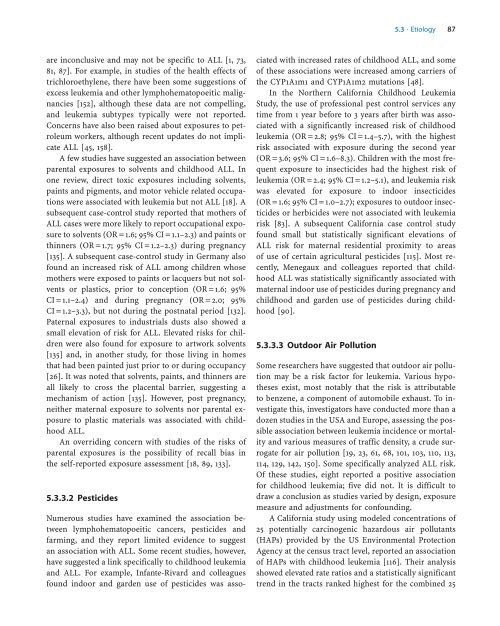Acute Leukemias - Republican Scientific Medical Library
Acute Leukemias - Republican Scientific Medical Library
Acute Leukemias - Republican Scientific Medical Library
Create successful ePaper yourself
Turn your PDF publications into a flip-book with our unique Google optimized e-Paper software.
a 5.3 · Etiology 87<br />
are inconclusive and may not be specific to ALL [1, 73,<br />
81, 87]. For example, in studies of the health effects of<br />
trichloroethylene, there have been some suggestions of<br />
excess leukemia and other lymphohematopoeitic malignancies<br />
[152], although these data are not compelling,<br />
and leukemia subtypes typically were not reported.<br />
Concerns have also been raised about exposures to petroleum<br />
workers, although recent updates do not implicate<br />
ALL [45, 158].<br />
A few studies have suggested an association between<br />
parental exposures to solvents and childhood ALL. In<br />
one review, direct toxic exposures including solvents,<br />
paints and pigments, and motor vehicle related occupations<br />
were associated with leukemia but not ALL [18]. A<br />
subsequent case-control study reported that mothers of<br />
ALL cases were more likely to report occupational exposure<br />
to solvents (OR = 1.6; 95% CI = 1.1–2.3) and paints or<br />
thinners (OR =1.7; 95% CI = 1.2–2.3) during pregnancy<br />
[135]. A subsequent case-control study in Germany also<br />
found an increased risk of ALL among children whose<br />
mothers were exposed to paints or lacquers but not solvents<br />
or plastics, prior to conception (OR = 1.6; 95%<br />
CI =1.1–2.4) and during pregnancy (OR = 2.0; 95%<br />
CI =1.2–3.3), but not during the postnatal period [132].<br />
Paternal exposures to industrials dusts also showed a<br />
small elevation of risk for ALL. Elevated risks for children<br />
were also found for exposure to artwork solvents<br />
[135] and, in another study, for those living in homes<br />
that had been painted just prior to or during occupancy<br />
[26]. It was noted that solvents, paints, and thinners are<br />
all likely to cross the placental barrier, suggesting a<br />
mechanism of action [135]. However, post pregnancy,<br />
neither maternal exposure to solvents nor parental exposure<br />
to plastic materials was associated with childhood<br />
ALL.<br />
An overriding concern with studies of the risks of<br />
parental exposures is the possibility of recall bias in<br />
the self-reported exposure assessment [18, 89, 133].<br />
5.3.3.2 Pesticides<br />
Numerous studies have examined the association between<br />
lymphohematopoeitic cancers, pesticides and<br />
farming, and they report limited evidence to suggest<br />
an association with ALL. Some recent studies, however,<br />
have suggested a link specifically to childhood leukemia<br />
and ALL. For example, Infante-Rivard and colleagues<br />
found indoor and garden use of pesticides was asso-<br />
ciated with increased rates of childhood ALL, and some<br />
of these associations were increased among carriers of<br />
the CYP1A1m1 and CYP1A1m2 mutations [48].<br />
In the Northern California Childhood Leukemia<br />
Study, the use of professional pest control services any<br />
time from 1 year before to 3 years after birth was associated<br />
with a significantly increased risk of childhood<br />
leukemia (OR = 2.8; 95% CI=1.4–5.7), with the highest<br />
risk associated with exposure during the second year<br />
(OR = 3.6; 95% CI = 1.6–8.3). Children with the most frequent<br />
exposure to insecticides had the highest risk of<br />
leukemia (OR = 2.4; 95% CI=1.2–5.1), and leukemia risk<br />
was elevated for exposure to indoor insecticides<br />
(OR = 1.6; 95% CI = 1.0–2.7); exposures to outdoor insecticides<br />
or herbicides were not associated with leukemia<br />
risk [83]. A subsequent California case control study<br />
found small but statistically significant elevations of<br />
ALL risk for maternal residential proximity to areas<br />
of use of certain agricultural pesticides [115]. Most recently,<br />
Menegaux and colleagues reported that childhood<br />
ALL was statistically significantly associated with<br />
maternal indoor use of pesticides during pregnancy and<br />
childhood and garden use of pesticides during childhood<br />
[90].<br />
5.3.3.3 Outdoor Air Pollution<br />
Some researchers have suggested that outdoor air pollution<br />
may be a risk factor for leukemia. Various hypotheses<br />
exist, most notably that the risk is attributable<br />
to benzene, a component of automobile exhaust. To investigate<br />
this, investigators have conducted more than a<br />
dozen studies in the USA and Europe, assessing the possible<br />
association between leukemia incidence or mortality<br />
and various measures of traffic density, a crude surrogate<br />
for air pollution [19, 23, 61, 68, 101, 103, 110, 113,<br />
114, 129, 142, 150]. Some specifically analyzed ALL risk.<br />
Of these studies, eight reported a positive association<br />
for childhood leukemia; five did not. It is difficult to<br />
draw a conclusion as studies varied by design, exposure<br />
measure and adjustments for confounding.<br />
A California study using modeled concentrations of<br />
25 potentially carcinogenic hazardous air pollutants<br />
(HAPs) provided by the US Environmental Protection<br />
Agency at the census tract level, reported an association<br />
of HAPs with childhood leukemia [116]. Their analysis<br />
showed elevated rate ratios and a statistically significant<br />
trend in the tracts ranked highest for the combined 25
















